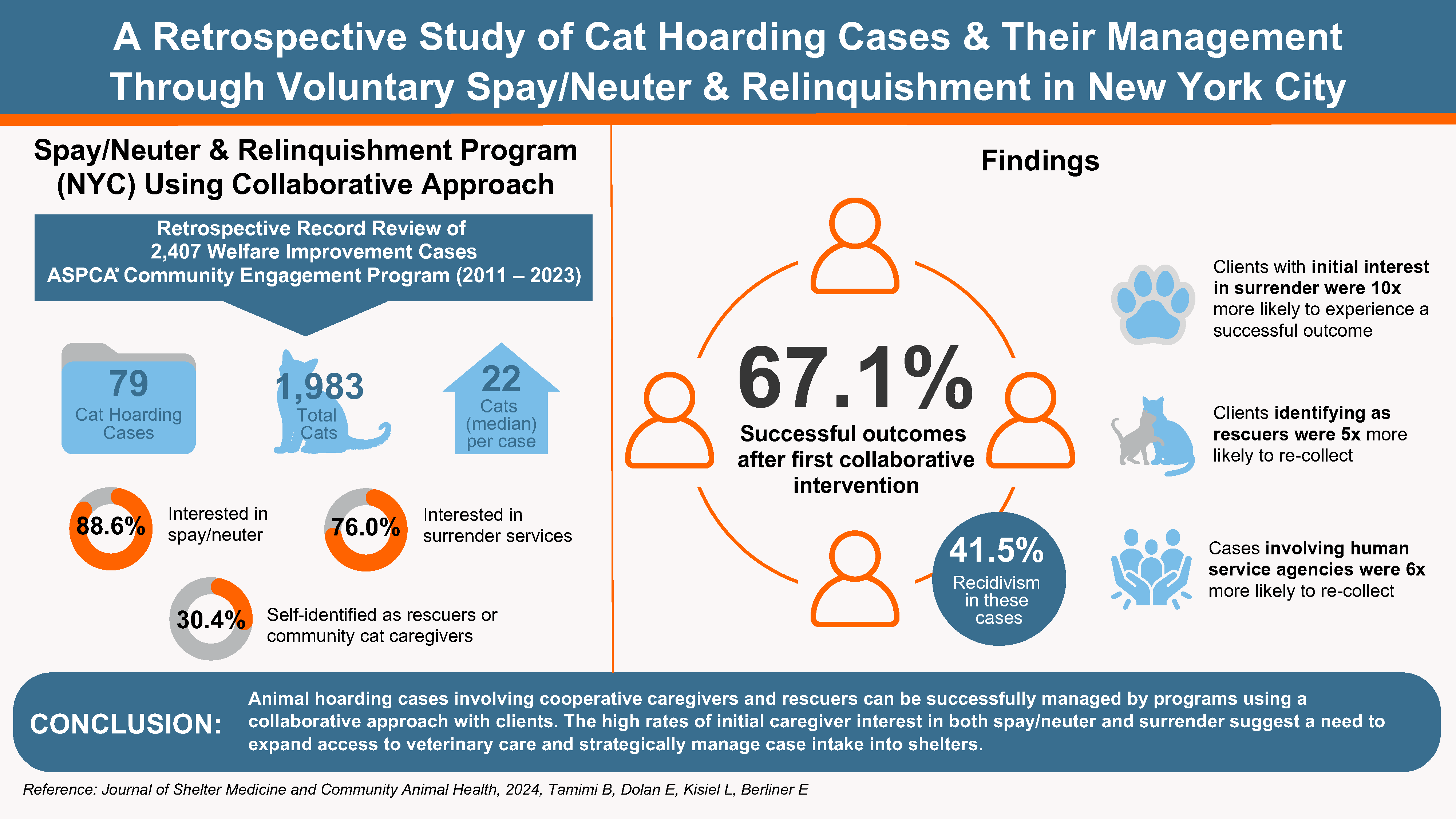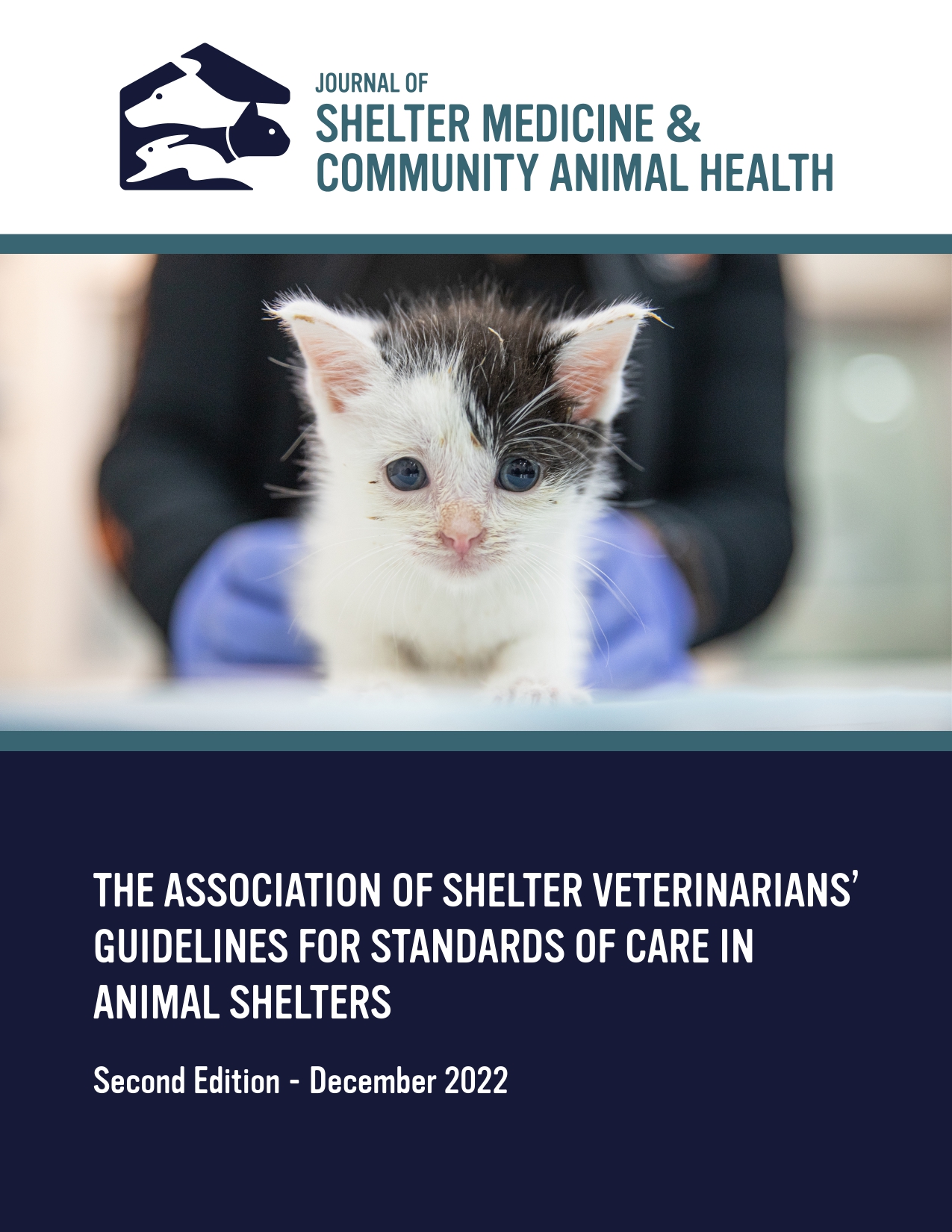A Retrospective Study of Cat Hoarding Cases and Their Management Through Voluntary Spay/Neuter and Relinquishment In New York City
DOI:
https://doi.org/10.56771/jsmcah.v3.92Keywords:
animal hoarding, access to care, humane investigations, harm reduction, social vulnerability indexAbstract
Introduction: Animal hoarding cases are complex sources of shelter intake. Cases require significant planning, collaboration, and resources, often from multiple responding organizations. Study objectives included description of cat hoarding cases in New York City not criminally pursued, case outcomes when managed by a spay/neuter and relinquishment program utilizing a collaborative approach with caregivers, and characteristics or interventions leading to better outcomes.
Methods: Data were extracted from the American Society for the Prevention of Cruelty to Animal’s Community Engagement (CE) case files. Eligible cases were retrieved using a keyword search and screened for inclusion criteria. Client demographics, case factors, and outcomes were described with descriptive statistics. Data were further analyzed using adjusted logistic regression models to investigate variables predictive of outcomes.
Results: The study population included 79 cases with a median population size of 22 cats. The majority of clients were female, lived alone, and had high levels of social vulnerability. Object hoarding was reported in 29.1% of cases and unsanitary conditions in 68.4% of cases. Almost one-third (30.4%) identified as rescuers or community cat caregivers. At the time of the first interaction with CE, 88.6% of clients were interested in spay/neuter and 76.0% in surrender services. Social service agencies were involved in the initial CE intervention in 26.4% of cases.
Successful outcomes were defined as cases in which clients were left with a manageable population of cats, or all cats were removed. Successful outcomes were achieved in 67.1% of cases after the first CE intervention. Recidivism occurred in 41.5% of these cases. Clients who showed an initial interest in surrender were 10 times more likely (OR 10.0, P = 0.014) to experience a successful outcome than clients not interested in surrender. Significant predictors of re-collection included clients identifying as rescuers (OR 4.8, P = 0.039) and the involvement of human service agencies during or after the CE intervention (OR 6.1, P = 0.041).
Conclusion: Results demonstrate animal hoarding cases involving cooperative caregivers and rescuers can be successfully managed by programs using a collaborative approach with clients. The high rates of initial interest in spay/neuter and surrender in caregivers suggest a need to expand access to veterinary care and strategically manage case intake into shelters. Further interdisciplinary research is needed on how mental health, social service, and animal service providers can attain successful outcomes long-term and reduce recidivism in animal hoarding cases.
Downloads
References
Worth D, Beck AM. Multiple ownership of animals in New York city. Trans Stud Coll Physicians Phila. 1981;3(4): 280–300. https://www.researchgate.net/publication/16154860. Accessed December 22, 2023.
Avery L. From helping to hurting: when acts of ‘good Samaritans’ become felony animal cruelty. Valparaiso Univ Law Rev. 2005;39(4):815–858. https://heinonline.org/HOL/License. Accessed December 22, 2023.
Reinisch AI. Characteristics of six recent animal hoarding cases in Manitoba. Can Vet J. 2009;50:1069–1073.
Sacchettino L, Gatta C, Giuliano VO, et al. Description of twenty-nine animal hoarding cases in Italy: the impact on animal welfare. Animals. 2023;13(18):2968. doi: 10.3390/ani13182968
Calvo P, Duarte C, Bowen J, Bulbena A, Fatjo J. Characteristics of 24 cases of animal hoarding in Spain. Anim Welfare. 2014;23(2):199–208. doi: 10.7120/09627286.23.2.199
Joffe M, Shannessy DO, Dhand NK, Westman M, Fawcett A. Characteristics of persons convicted for offences relating to animal hoarding in New South Wales. Aust Vet J. 2014;92(10):369–375. doi: 10.1111/avj.12249
Ferreira EA, Paloski LH, Costa DB, et al. Animal hoarding disorder: a new psychopathology? Psychiatry Res. 2017;258: 221–225. doi: 10.1016/j.psychres.2017.08.030
da Cunha GR, Martins CM, de Fatima Ceccon-Valente M, et al. Frequency and spatial distributation of animal and object hoarder behavior in Curitiba Paraná State, Brazil. Cad Saude Publica. 2017;33(2). doi: 10.1590/0102-311x00001316
Ockenden E, De Groef B, Marston L. Animal hoarding in Victoria, Australia: an exploratory study. Anthrozoos. 2014;27(1):33–47. doi: 10.2752/175303714X13837396326332
Elliott R, Snowdon J, Halliday G, Hunt GE, Coleman S. Characteristics of animal hoarding cases referred to the RSPCA in New South Wales, Australia. Aust Vet J. 2019;97(5):149–156. doi: 10.1111/avj.12806
Dozier ME, Bratiotis C, Broadnax D, Le J, Ayers CR. A description of 17 animal hoarding case files from animal control and a humane society. Psychiatry Res. 2019;272:365–368. doi: 10.1016/j.psychres.2018.12.127
American Psychiatric Association. Obsessive-compulsive and related disorders. In: American Psychiatric Association (APA), ed. Diagnostic and Statistical Manual of Mental Disorders. 5th ed. American Psychiatric Association Publishing; 2022. doi: 10.1176/appi.books.9780890425787
Arluke A, Patronek G, Lockwood R, Cardona A. Animal hoarding. In: Maher J, Pierpoint H, Beirne P, eds. The Palgrave International Handbook of Animal Abuse Studies. London: Springer Nature; 2017:107–129. doi: 10.1057/978-1-137-43183-7
Ferreira EA, Paloski LH, Costa DB, Moret-Tatay C, Irigaray TQ. Psychopathological comorbid symptoms in animal hoarding disorder. Psychiatr Q. 2020;91(3):853–862. doi: 10.1007/s11126-020-09743-4
Patronek G, Loar L, Nathanson J. Animal Hoarding: Structuring Interdisciplinary Responses to Help People, Snimals and Communities at Risk. 2006. www.tufts.edu/vet/cfa/hoarding. Accessed February 22, 2023.
Patronek GJ. Animal hoarding: its roots and recognition. Vet Med. 2006;101(8):520–530.
Lockwood R. Animal hoarding: the challenge for mental health, law enforcement, and animal welfare professionals. Behav Sci Law. 2018;36(6):698–716. doi: 10.1002/bsl.2373
Polak KC, Levy JK, Crawford PC, Leutenegger CM, Moriello KA. Infectious diseases in large-scale cat hoarding investigations. Vet J. 2014;201(2):189–195. doi: 10.1016/j.tvjl.2014.05.020
Berry C, Patronek G, Lockwood R. Long-term outcomes in animal hoarding cases. Anim Law. 2015;11:11–167. https://heinonline.org/HOL/License. Accessed February 29, 2024.
Hoarding of Animals Research Consortium (HARC). Health implications of animal hoarding. Health Soc Work. 2002;27(2):125–136. doi: 10.1093/hsw/27.2.125
Strong S, Federico J, Banks R, Williams C. A collaborative model for managing animal hoarding cases. J Appl Anim Welfare Sci. 2019;22(3):267–278. doi: 10.1080/10888705.2018.1490183
Jacobson LS, Giacinti JA, Robertson J. Medical conditions and outcomes in 371 hoarded cats from 14 sources: a retrospective study (2011–2014). J Feline Med Surg. 2020;22(6):484–491. doi: 10.1177/1098612X19854808
Stumpf BP, Calacio B, Branca B, Wilnes B. Animal hoarding: a systematic review. Braz J Psychiatry. 2023;45(4):356–365. doi: 10.47626/1516
Patronek GJ. Hoarding of animals: an under-recognized public health problem in a difficult-to-study population. Public Health Rep. 1999;114:81–87. doi: 10.1093/phr/114.1.81
Steketee G, Gibson A, Frost RO, Alabiso J, Arluke A, Patronek G. Characteristics and antecedents of people who hoard animals: an exploratory comparative interview study. Rev Gen Psychol. 2011;15(2):114–124. doi: 10.1037/a0023484
Snowdon J, Halliday G, Elliott R, Hunt GE, Coleman S. Mental health of animal hoarders: a study of consecutive cases in New South Wales. Aust Health Rev. 2020;44(3):480–484. doi: 10.1071/AH19103
Wilkinson J, Schoultz M, King HM, Neave N, Bailey C. Animal hoarding cases in England: implications for public health services. Front Public Health. 2022;10:899378. doi: 10.3389/fpubh.2022.899378
Center for Disease Control (CDC), Agency for Toxic Substances and Disease Registry (ATSDR). CDC/ATSDR Social Vulnerability Index. 2024. https://www.atsdr.cdc.gov/placeandhealth/svi/index.html. Accessed December 14, 2023.
Pinillos RG. One Welfare: A Framework to Improve Animal Welfare and Human Well-Being. Wallingford: C.A.B. International; 2018. doi: 10.1079/9781786393845.0000
García Pinillos R, Appleby MC, Manteca X, Scott-Park F, Smith C, Velarde A. One welfare: a platform for improving human and animal welfare. Vet Record. 2016;179(16):412–413. doi: 10.1136/vr.i5470
Cahill A, Cusick A, Englebright L. Assembly Bill A261. 2019. https://legislation.nysenate.gov/pdf/bills/2019/A261. Accessed February 19, 2024.
Hawk M, Coulter RWS, Egan JE, et al. Harm reduction principles for healthcare settings. Harm Reduct J. 2017;14(1):70. doi: 10.1186/s12954-017-0196-4
Substance Abuse and Mental Health Services Administration. Harm Reduction Framework. 2023. https://www.samhsa.gov/find-help/harm-reduction/. Accessed March 24, 2024.
World Organization for Animal Health. Animal Welfare: The Five Freedoms. Animal Welfare at WOAH; 2024. https://www.woah.org/en/what-we-do/animal-health-and-welfare/animal-welfare/. Accessed February 19, 2024.
Frost RO, Patronek G, Rosenfield E. Comparison of object and animal hoarding. Depress Anxiety. 2011;28:885–891. doi: 10.1002/da.20826
Human Animal Support Services. The HASS Playbook. 2024. https://www.humananimalsupportservices.org/hass-playbook/. Accessed December 22, 2023.
Arkow P. Human–animal relationships and social work: opportunities beyond the veterinary environment. Child Adolesc Soc Work J. 2020;37(6):573–588. doi: 10.1007/s10560-020-00697-x
Hoy-Gerlach J, Ojha M, Arkow P. Social workers in animal shelters: a strategy toward reducing occupational stress among animal shelter workers. Front Vet Sci. 2021;8:1–10. doi: 10.3389/fvets.2021.734396
Access to Veterinary Care Coalition. Access to Veterinary Care: Barriers, Current Practices, and Public Policy. 2018. https://trace.tennessee.edu/utk_smalpubs/17. Accessed November 28, 2023.
Neal SM, Greenberg MJ. Putting access to veterinary care on the map: a veterinary care accessibility index. Front Vet Sci. 2022;9:857644. doi: 10.3389/fvets.2022.857644
Bunke L, Harrison S, Angliss G, Hanselmann R. Establishing a working definition for veterinary care desert. J Am Vet Med Assoc. 2023;262:1–8. doi: 10.2460/javma.23.06.0331
Newbury S, Hurley K. Population management. In: Miller L, Zawistowski S, eds. Shelter Medicine for Veterinarians and Staff. 2nd ed. Ames: John Wiley & Sons, Inc.; 2013:93–113.
The Association of Shelter Veterinarians. The Guidelines for Standards of Care in Animal Shelters. J Shelter Med Community Anim Health. 2022. doi: 10.56771/ASVguidelines.2022
Brown SE. Theoretical concepts from self psychology applied to animal hoarding. Soc Anim. 2011;19(2):175–193. doi: 10.1163/156853011X563006
Sen. Gianaris. Senate Bill S8543. 2024. https://legislation.nysenate.gov/pdf/bills/2023/S8543. Accessed March 2, 2024.

Published
Issue
Section
License
Copyright (c) 2024 Biana Tamimi, Lisa Kisiel, Emily Dolan, Elizabeth Berliner

This work is licensed under a Creative Commons Attribution 4.0 International License.









